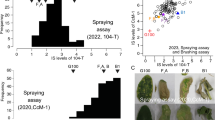Abstract
Anthracnose of grapevine, caused by the fungus Sphaceloma ampelinum de Bary, the anamorph stage of Elsinoe ampelina, is one of the major diseases of grapevine (Vitis vinifera L.) in the tropics. Ten grapevine cultivars/lines and 24 F1 hybrids were evaluated for resistance to anthracnose in the laboratory, using an excised leaf technique with two anthracnose isolates (Nk4-1 and Rc2-1), and in the field by using natural infection during 2007 and 2009. Significant differences in the lesion/disease scores among grapevine genotypes, ranging from 1 (resistant) to 5 (susceptible), were observed under both laboratory and field conditions, but ranking of genotypes may vary between screening methods. No significant difference in disease severity was observed among three consecutive years of field evaluations. Resistance evaluations under both conditions consistently classified ‘Wilcox 321’, ‘NY88.0507.01’, ‘NY65.0550.04’ and ‘Illinois 547-1’ as resistant lines useful as parents for future breeding programs. Moreover, one F1 hybrid ‘SUT0404.40’, was found to be resistant to both isolates under laboratory and field evaluations. The resistance levels of 34 grape genotypes evaluated under laboratory (using isolates Nk4-1 and Rc2-1) and field conditions gave consistent results with Spearman’s rank correlation coefficients of 0.72 and 0.71 (P ≤ 0.01), respectively, suggesting that this laboratory screening assay is efficient for rapid, reliable and economical identification of resistant hybrids in grapevine breeding programs.
Similar content being viewed by others
References
CAB International (2000) Crop protection compendium. CAB International, Wallingford
Cowley RB, Ash GJ, Harper JDI, Orchard BA, Luckett DJ (2008) Using detached leaves and pods to screen for resistance to phomopsis (Diaporthe toxica) in Lupinus albus. Proceedings of the 12th International Lupin Conference. 14–18 Sept. 2008, Fremantle, Western Australia. pp. 308–311
Dabholkar AR (1992) Elements of biometrical genetics. Concept Publishing Company, New Delhi
Fennell JL (1948) Inheritance studies with the tropical grape. J Hered 34:54–64
Hopkins DL, Harris JW (2000) A greenhouse method for screening grapevine seedlings for resistance to anthracnose. HortScience 35:89–91
Irwin JAG, Musial JM, Mackie JM, Basford KE (2003) Utility of cotyledon and detached leaf assays for assessing root reactions of lucerne to Phytophthora root rot caused by Phytophthora medicaginis. Aust Plant Pathol 32:263–268
Jindal PC, Shankar B (2000) Studies on phytoalexins in screening grape germplasm for anthracnose resistance. Indian J Hort 57(1):47–50
Jindal PC, Shankar B (2002) Screening of grape germplasm against anthracnose (Sphaceloma ampelinum de Bary). Indian J Agr Res 36(2):145-148
Kim HS, Hartman GL, Manandhar JB, Graef GL, Steadman JR, Diers BW (2000) Reaction of soybean cultivars to Sclerotinia stem rot in field, greenhouse, and laboratory evaluations. Crop Sci 40:665–669
Levesque R, Inc SPSS (2006) SPSS programming and data management, 3rd edn. SPSS Institute, Somers
Li D, Wan Y, Wang Y, He P (2008) Relatedness of resistance to anthracnose and to white rot in Chinese wild grapes. Vitis 47:213–215
Louime C, Lu J, Onokpise O, Vasanthaiah HKN, Kambiranda D, Basha SM, Yun HK (2011) Resistance to Elsinoë ampelina and expression of related resistant genes in Vitis rotundifolia Michx. Grapes. Int J Mol Sci 12:3473–3488
Lu J (1997) Oriental Vitis species-A new germplasm source for Florida grape breeding? Proc Fla State Hort Soc 110:166–168
Mortensen JA (1981) Sources and inheritance of resistance to anthracnose in Vitis. J Hered 72:423–426
Nelson BD, Helms TC, Olson MA (1991) Comparison of laboratory and field evaluations of resistance in soybean to Sclerotinia sclerotiorum. Plant Dis 75:662–665
Okelola FS, Adebisi MA, Kehinde OB, Ajala MO (2007) Genotypic and phenotypic variability for seed vigour traits and seed yield in West African rice (Oryza sativa L.) genotypes. J Amer Sci 3(3):34–41
Patil SG, Honrao BK, Rao VG, Patil VP (1990) Field evaluation of grape germplasm for resistance against anthracnose. Biovigyanam 16:69–72
Pienpuck K, Choobamroong W, Kueprakone U (1993) Sphaceloma ampelinum of grape scab in Thailand. Thai Agri Res J 11(2):66–72
Poolsawat O, Tharapreuksapong A, Wongkaew S, Tantasawat P (2009) Cultural characteristics of Sphaceloma ampelinum, causal pathogen of grape anthracnose on different media. Suranaree J Sci Technol 16:149–157
Poolsawat O, Tharapreuksapong A, Wongkaew S, Reisch B, Tantasawat P (2010) Genetic diversity and pathogenicity analysis of Sphaceloma ampelinum causing grape anthracnose in Thailand. J Phytopathol 158:837–840
Spearman C (1904) The proof and measurement of association between two things. Am J Psycho 15:72–101
Tharapreuksapong A, Poolsawat O, Jenweerawat S, Wongkaew S, Tantasawat P (2009) Molecular, morphological and pathogenicity characterization of Sphaceloma ampelinum isolates from Thailand. Acta Hort 827:611–618
Tian L, Wang Y, Niu L, Tang D (2008) Breeding of disease-resistant seedless grapes using Chinese wild Vitis spp. I. In vitro embryo rescue and plant development. Sci Hort 117:136–141
Wegulo SN, Yang XB, Martinson CA (1998) Soybean cultivar responses to Sclerotinia sclerotiorum in field and controlled environment studies. Plant Dis 82:1264–1270
Yun HK, Park KS, Rho JH, Choi YJ, Kang KK (2006) Evaluating the resistance of grapevines against anthracnose by pathogen inoculation, vineyard inspection, and bioassay with culture filtrate from Elsinoe ampelina. J Amer Pomol Soc 60:97–103
Acknowledgements
We are very grateful to Dr. Bruce I. Reisch for providing resistant line cuttings and advice. This research is partially supported by the Higher Education Research Promotion and National Research University Project of Thailand, Office of the Higher Education Commission, the Center of Excellence on Agricultural Biotechnology, Science and Technology Postgraduate Education and Research Development Office, Office of the Higher Education Commission, Ministry of Education (AG-BIO/PERDO-CHE), and grants from Suranaree University of Technology, Thailand.
Author information
Authors and Affiliations
Corresponding author
Rights and permissions
About this article
Cite this article
Poolsawat, O., Tharapreuksapong, A., Wongkaew, S. et al. Laboratory and field evaluations of resistance to Sphaceloma ampelinum causing anthracnose in grapevine. Australasian Plant Pathol. 41, 263–269 (2012). https://doi.org/10.1007/s13313-012-0127-5
Received:
Accepted:
Published:
Issue Date:
DOI: https://doi.org/10.1007/s13313-012-0127-5




